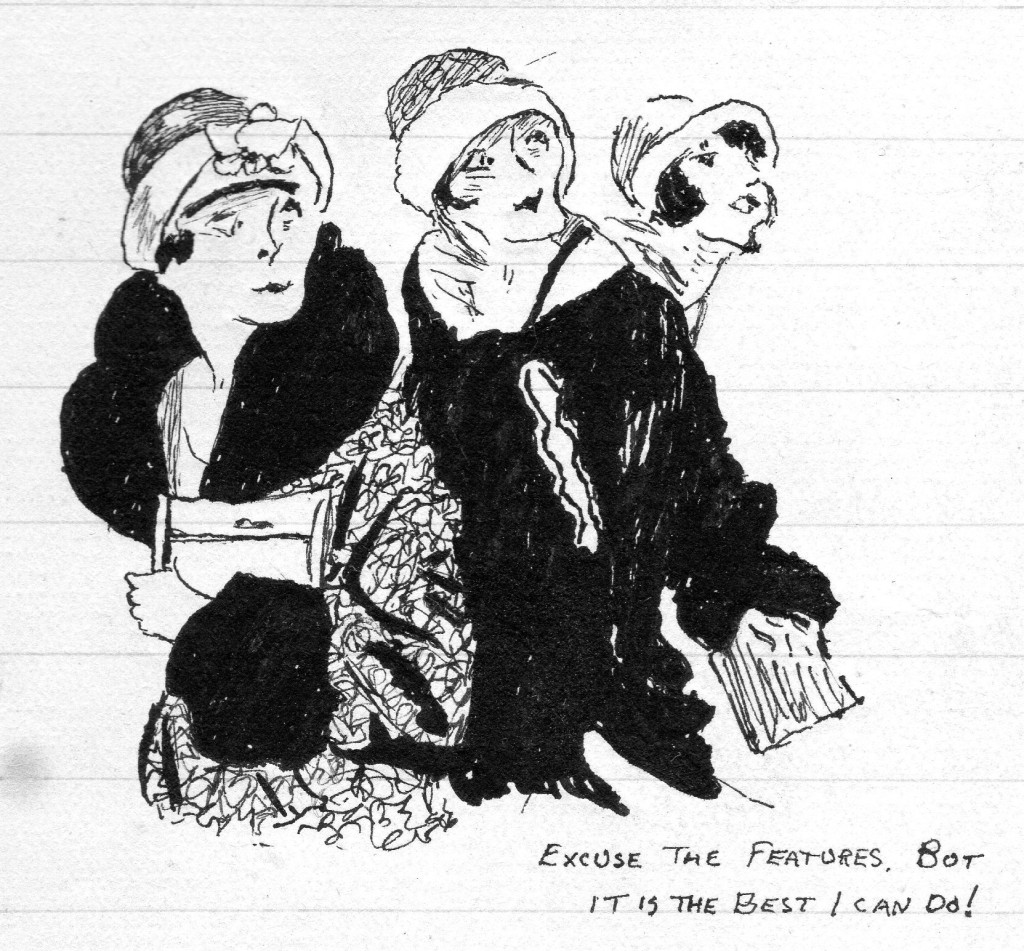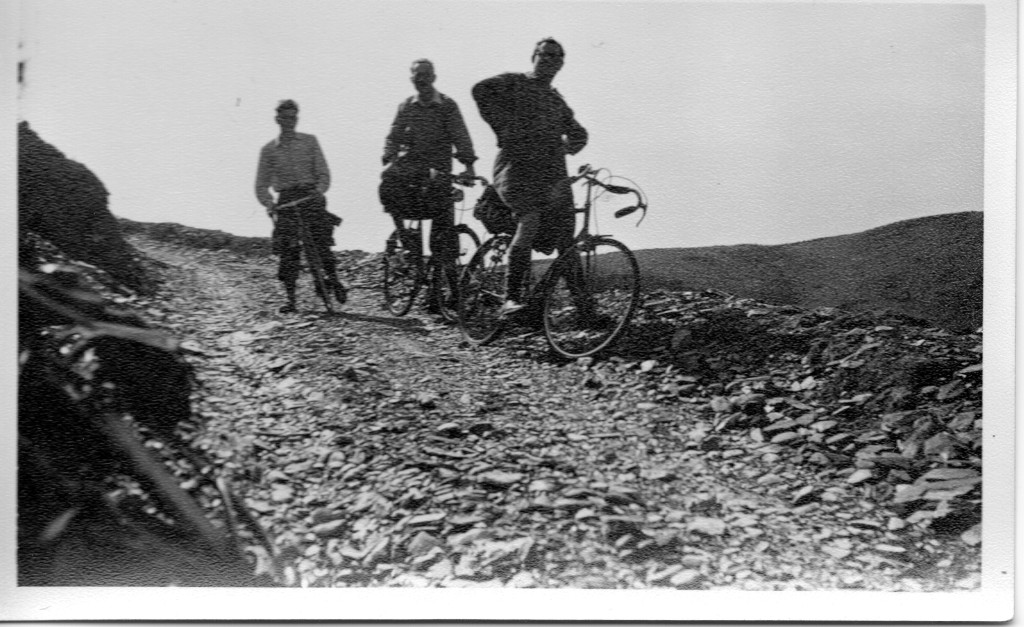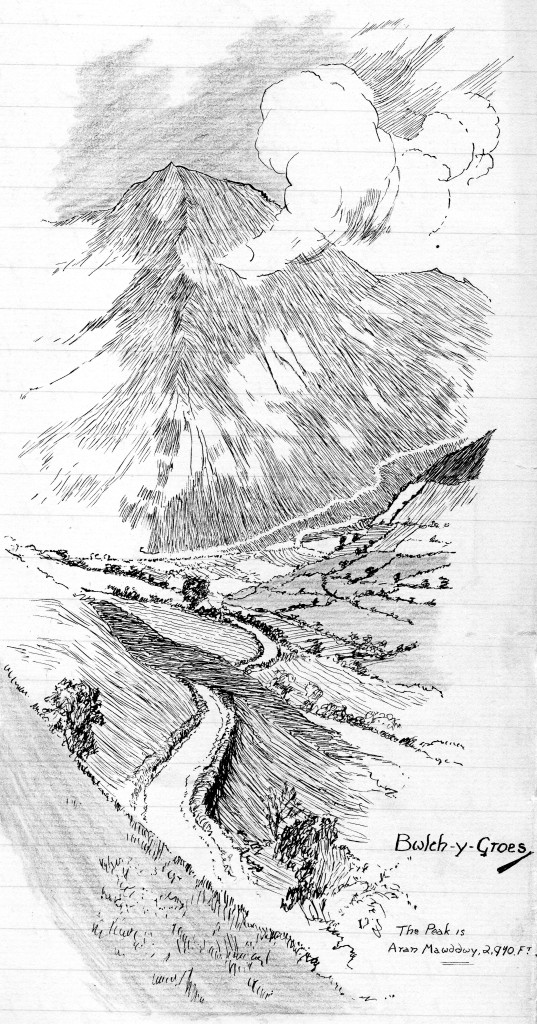Part Four: Mynydd Hiraethog
The joys of touring ! One razor that could have been sharper for three of us, with cold water, so that it felt, during the process of shaving, like a chicken would feel being plucked alive; an attic so low at the walls that, as you sleepily rose in bed you got a nasty whack on the head that drove all thoughts of sleep away and brought forth a torrent of lurid oaths. At least that would have happened had I not noticed that the rest, with such suspiciously innocent faces, sat waiting for me to get up. I disappointed them. Before breakfast I walked down to where the ever vivacious Llugwy was dashing itself over the rocks below Pont Cyfyng. The rock about Cyfyng Falls, has been worn remarkably deep and smooth in curves and crevices by the action of countless million gallons of water over a period of thousands and thousands of years. Stood musing on this and other facts and marvelling over it all, I lost all thoughts of time until Joe, in a voice that is no longer sweet and low, announced that breakfast was ready, and I abandoned my ponderings in favour of more urgent demands. Our breakfasts were at 8.30 – what the others called early; I often kicked up a row over it, for 7.30 is late enough, because I think that for touring, there is nothing like an early start. It is the same at night, for whilst many like to finish soon after tea, I’d rather ride until the very last minute, say 10 to 10.30 pm. Of course, one has to ‘touch wood’ to get digs at that hour – and that is where the fun comes in ! At long last, after the usual delays, we bade Mrs Jones and all the little Jones’s good-day, and kicked off.
Moel Siabod had lost its wraith during the night and now stood out as clear as a bell, in a perfect sky. Bettws-y-Coed was quiet – the morning motor trek was not astir yet, and we had the Holyhead Road pretty much to ourselves. We broke the long grind up Dinas Hill with a journey to Conway Falls, said journey costing us two pence each. Joe thought that they should pay us for descending all the steps, then ascending them back. The falls were but a shadow of what we (Tom and I) witnessed at New Year, being so much shrunken that I was able to scramble round the base of the ‘sump’, where the water whirls round in flood time with terrific fury, and look up the chasm from where the falls commence. In this gorge was a series of steps, each of which formed a little fall, though in flood time the whole would be one racing torrent. The pretty wood-lands of Dinas Hill petered out as we reached the summit, and in company with the now youthful Conway, reached Pentrefoelas, with our tongues cleaving to our mouths. This was remedied for the nonce at an obliging tap. Here we abandoned the Holyhead Road and joined the Denbigh Road, a high byway that I knew would amply repay the ‘collar-work’ we should be called upon to do. As expected, the start was not exactly alluring, extremely rough and rutty, but as it was mostly walking the roughness counted for little.
Gradually we climbed onto the open moors, the expansive Mynydd Hiraethog, into the full heat of the sun, which brought the skin off my arms, whilst westwards, the Shire-Carnarvon peaks hove into view. A lake on our left, cupped in the brown moors was surprisingly blue. I have never before – or since – seen water show such a deep beautiful hue. Meanwhile our search for a stream to drink, started on Dinas Hill, was fruitless – I don’t know how they go on in the tropics, it was bad enough here. The mountains had gradually appeared until, now, supremely set behind a rolling expanse of heather and moss, the magnificent barriers of rock stood against the faultless sky. From the long grey ridges of the Carneddau, over the sheer, triple-headed Trifan, the ragged Glyder group to the magnificent mass culminating in the graceful peak of Eryri, our eyes wandered, down past the clear sweep of Siabod to the guardians of the gorgeous Vale of Dwyryd and the misty peaks of Ardudwy, a long saw edge of splendid mountains. They hold a magnetic attraction someway, these Cambrian giants, they always seem to beckon me to go among them, and when we have been we are not satisfied – we want to go again ! The following verse from Byron explains, perhaps, why Wales so persistently calls to us, though elsewhere will be found the reason why only Wales seems to satisfy me.
He who first met the highland’s swelling blue
Will love each peak that shows a kindred hue
Hails in every crag a friend’s familiar face,
And clasp the mountains in his mind’s embrace.
From the summit, where stands the little Sportsman’s Arms, at an altitude of 1523 feet, we had a breathless succession of downhill sweeps on a superb surface, the while the western peaks one by one dropped out of sight, and the Clwydian earth-clods lined themselves across the eastern sky, and the rolling, swelling half-greenery unfurled itself before our eyes; the high, brown Hiraethog Mountains from the roof of which we had just descended, rolling away to the ultimate humps and blunt ridges behind us. We flew through Bylchau, down the woods of Groes, blinded along pastoral foothills until we came in sight of the ruin-clad hill of Denbigh Castle, very soon finding ourselves in the ancient capital of Clwyd. We got the lunch of our hearts at a café over a grocer’s shop – no fear of a food shortage here !
 Some slight difficulty was experienced in getting out of Denbigh, our wanderings leading us to what we took for a museum of antiquated vehicles or an ancient cab-house, though afterwards we ascertained that it was the fire station !
Some slight difficulty was experienced in getting out of Denbigh, our wanderings leading us to what we took for a museum of antiquated vehicles or an ancient cab-house, though afterwards we ascertained that it was the fire station !
We had 16 miles to cover to Mold, and by the way we started blinding we bade fair to set up a new record. Crossing the Vale of Clwyd, I was struck by the very green-ness of everything, perhaps more noticeable after the brown moors of Hiraethog. This road would be passing pretty if it was a bit hillier and less motorised, for the long, level stretches palled on us, and the Bank Holiday traffic was showing itself. So, though passing between hills, we blinded hotly right through Mold, where well known roads hurried us on for another six miles to Pen-y-Mynydd, where a grassy bank proved a temptation irresistible. Whilst sprawling here two pretty girls passed with a dog, and Billy, ever ready to seize on a joke, made humorous assertions relative to it. Like true flappers, answers were forthcoming, and a dialogue ensued that set everyone rocking with merriment. All the way to Chester it was the same, one continual round of jokes. At length Chester was reached and our circuit was completed, Chester to Chester, without covering the same roads twice at any point except, perhaps, the two miles, Dinas Mawddwy-Mallwyd, and the Capel-Ogwen detour. We had tea at Frodsham, where we implored Mrs Littler to lay us the first square meal of the tour, just to get her to make a bust-up, and a bust-up it was, a worthy last meal for a tour like this was.
In the last glow of a perfect evening we pottered down to Warrington in company with the hosts of youthful, would-be, cyclists who, having survived Good Friday’s day out, were essaying the second ride of their lives, and were feeling the effects to judge from looks both fore and aft. We were all bronzed and merry, drawing more than a bit of attention from passers-by. Tom left us at the canal bridge, to make his way home via Lymm and Altrincham, and we four, with a Bolton CTC-ite we had picked up passed through the notorious bottle-neck to Winwick and Lowton, where Billy and Fred struck off to Hindley whilst we endured the Leigh ‘setts’, arriving home at 10pm, and thus spending the holiday almost to the last minute.
And now, as always after touring, comes the reckoning; the weighing of disadvantages against advantage, the cost, and the final question: is it worth it ? To weigh advantage and disadvantage is to weigh a sack of potatoes against a feather, whilst as for the cost, to me it amounted to just about 80 shillings, that is seven and sixpence a day including all expenses. I defy anyone to cover the ground we did, see what we saw, enjoy life as we did and feel so well as we did other than by cycle at so low a cost. To ask: “Is it worth it?” is merely superfluous, we never were in doubt of it before we started, and it only served to strengthen the view that for holidays, cycle touring is the only way.
The seven Passes still linger in my mind as I write, over 7 months later, Nant-y-Ffrith, sylvan and quiet, Bwlch-y-Groes, high and wild, the views and scars of Bwlch Oerdrws, the glittering crags of Tal-y-Llyn Pass, the deep blackness of Aberglaslyn by night, the immensity of all things in the Pass of Llanberis, and the evening romance of Nant Ffrancon. The weather was glorious, but altered itself strangely to give us the best effects of dull, hot, cold, mists, thunder and lightening, rain and brilliant sunshine, always just where it could be best appreciated. One disadvantage we did find, and that always must be faced, the thought of coming home again to the same old streets and the same old round, but with the memories of a holiday well spent and the thoughts of future holidays in the spirit of that wonderful Easter of 1926.
A rather insignificant point is the mileage, which was: Good Friday, 106, Saturday 58, Sunday 48, and the final day, 96, a total of 308 miles. 12 November 1926.








